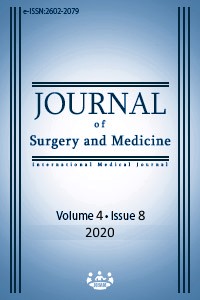Evaluation of cancer-related deaths in Turkey between 2009-2018: An epidemiological study
Keywords:
Cancer, Mortality, Pathology, DeathAbstract
Aim: Determination of cancer incidence and mortality data for all countries is essential for cancer control. These data can affect public health and clinical service planning. In this study, we aimed to examine the variability of cancer deaths in Turkey in terms of age groups, gender, geographic region, and years according to the cancer types between 2009-2018. Methods: In this epidemiological study, cancer-related mortality statistics data presented at the website of Turkey Statistical Institute (TSI) were used. Cancer-related deaths between 2009-2018 were evaluated in terms of ratio to total deaths, age groups, cancer types, geographical regions, and gender. Data were presented as percentages. Results: Cancer-related deaths were observed to increase between 2009-2018. The highest cancer-related mortality rate was seen in the Marmara Region, while it was lowest in the Southeastern Anatolia Region. Cancer-related death rate was higher in males than females, and it was highest in the 65-74 years age range. The most common cause of death in males is lung cancer, and in females, breast cancer. Conclusion: Cancer is responsible for 1/6 of all deaths in the world. Similarly, cancer-related deaths are responsible for approximately 1/5 of all deaths in our country. The risk of cancer in >60 years age group is higher in males than in females. In our country, all kinds of cancers, except female cancers, cause more deaths in males than females.
Downloads
References
Civil Registration: Why counting births and deaths is important? World Health Organization. Erişim Adresi: http://www.who.int/mediacentre/factsheets/fs324/en/ Erişim Tarihi: 09.02.2020.
Sümbüloğlu V, Gören A, Sümbüloğlu K.Ölüm Raporu Yazım Kılavuzu, TC Sağlık Bakanlığı Sağlık Projesi Genel Koordinatörlüğü Sağlık Enformasyon Sistemleri Eğitim Dizisi. Değiştirilmiş 2. Basım. No:3. Ankara: Aydoğdu Ofset; 1995. 3.
The top 10 causes of death. Why do we need to know the reasons people die? Media Center. World Health Organization. Erişim Tarihi: 09.02.2020. Erişim Adresi: http://www.who.int/mediacentre/factsheets/fs310/en/index2.html
Cancer Facts&Figures: 2019. American Cancer Society. 2019
Global Cancer Incidence and Mortality Rates and Trends—An Update Cancer. Epidemiol Biomarkers Prev. 2015;25(1):16–27.
World Cancer Report 2014. Geneva, Switzerland: World Health Organization, International Agency for Research on Cancer, WHO Press, 2015.
Cancer incidence and mortality projections in the UK until 2035. British Journal of Cancer. 2016;115:1147-55.
Global cancer statistics for the most common cancers. World wide cancer data. Erişim Adresi: https://www.wcrf.org/dietandcancer/cancer-trends/worldwide-cancer-data. Erişim Tarihi: 09.02.2020.
Risk Factors for Cancer. Cancer Causes and Prevention. National Cancer İnstitute. Erişim Adresi: https://www.cancer.gov/about-cancer/causes-prevention/risk. Erişim Tarihi: 09.02.2020.
Trends and Patterns of Cancer Mortality in North China (Hebei Province), 1973–2013. ScientifiC Reports. 2018;8:311.
Socioeconomic and Racial/Ethnic Disparities in Cancer Mortality, Incidence, and Survival in the United States, 1950–2014: Over Six Decades of Changing Patterns and Widening Inequalities. Hindawi Journal of Environmental and Public Health Volume 2017, Article ID 2819372, 19 pages
Singh GK, Siahpush M, Altekruse SF. Timetrendsin liver cancer mortality, incidence, and risk factors by unemployment level and race/ethnicity, United States,1969–2011. Journal of Community Health. 2013;38(5):926-40.
Blackwell DL, Lucas JW, Clarke TC. Summary health statistics for U.S. adults: national health interview survey, 2012. Vital and Health Statistics, vol.10, no.260, pp.1–161, 2014.
Singh GK, Williams SD, Siahpush M, Mulhollen A. Socioeconomic, rural-urban, and racial inequalities in US cancer mortality: Part I-all cancers and lung cancer and part II-colorectal, prostate, breast, and cervical cancers, Journal of Cancer Epidemiology. 2011;27:2011.
Singh GK, Miller BA, Hankey BF, Edwards BK. Area Socioeconomic Variations in U.S. Cancer Incidence, Mortality, Stage, Treatment, and Survival, 1975–1999, NCI Cancer Surveillance Monograph Series No. 4, NIH Publication No. 03-5417, National Cancer Institute, Bethesda, Md, USA, 2003, http://seer.cancer.gov/publications/ses/index.html.
Türkiye İstatistik Kurumu. Erişim Adresi: www.tuik.gov.tr. Erişim Tarihi: 09.02.2020.
Engelli ve Yaşlı İstatistik Bülteni. Engelli ve Yaşlı Hizmetleri Genel Müdürlüğü. 2019.
Ergör G. Türkiye Kronik Hastalılar ve Risk Faktörleri Sıklığı Çalışması: Diğer Bulaşıcı Olmayan Hastalıklar ve Kazalar. Türkiye Cumhuriyeti Sağlık Bakanlığı. Türkiye Halk Sağlığı Kurumu. Ankara. 2013.
Cancer. World Health Organization. [Internet]. [2018]. [cited 2019 February 28]. Available from: https://www.who.int/news-room/fact-sheets/detail/cancer
Türkiye’nin Nüfus Haritası. İç İşleri Bakanlığı, Yayın Tarihi: 11.07.2019. Erişim Adresi: https://www.icisleri.gov.tr/turkiyenin-nufus-haritasi
Özmen S, Ceylan O. Trends in lung cancer incidence of last 10 years: An Eastern Anatolian single center experience. J Surg Med. 2020;4(2):112-5.
Kutluk T, Kars A. Kanser Konusunda Genel Bilgiler. Kanser Savaş Dairesi Başkanlığı. Sağlık Bakanlığı. 2001.
Men’s Health Week: Men more likely to develop and die from cancer. Cancer Australia. Australian Goverment. Erişim Adresi: https://cancer australia.gov.au/about-us/news/mens-health-week-men-more-likely-develop-and-die-cancer. Erişim Tarihi: 09.02.2020.
Chlebowski RT, Manson JE, Anderson GL, Cauley JA, Aragaki AK, Stefanick ML, et al. Estrogen plus progestin and breast cancer incidence and mortality in the Women's Health Initiative Observational Study. J Natl Cancer Inst 2013;105:526–35.
Colditz GA, Baer HJ, Tamimi RM. Breast cancer. In:Schottenfeld D, Fraumeni JF Jr, editors. Cancer epidemiology and prevention. 3rd ed. New York: Oxford University Press; 2006. p. 995–1012.
Bruni L, Diaz M, Castellsagué X, Ferrer E, Bosch FX, de Sanjosé S. Cervical human papillomavirus prevalence in 5 continents: meta-analysis of 1 million women with normal cytological findings. J Infect Dis. 2010;202(12):1789-99. doi:10.1086/657321
Forman D, de Martel C, Lacey CJ, Soerjomataram I, Lortet-Tieulent J, Bruni L et al. Global burden of human papillomavirus and related diseases. Vaccine 2012;30 Suppl 5:F12–23
Herrero R, Parsonnet J, Greenberg ER. Prevention of gastric cancer. JAMA 2014;312:1197–8.
London WT, Mc Glynn KA. Liver cancer. In: Schottenfeld D, Fraumeni J Jr, editors. Cancer epidemiology and prevention. 3rd ed. New York: Oxford University Press; 2006. p. 763–86.
Global burden of cancer attributable to high body-mass index in 2012: a population-based study. Lancet Oncol 2015;16:36–46
Mathers CD, Loncar D. Projections of global mortality and burden of disease from 2002 to 2030. PLoS Med, 2006;3(11):e442.
Downloads
- 673 1436
Published
Issue
Section
How to Cite
License
Copyright (c) 2020 Havva Hande Keser Şahin, Orhan Aslan, Mustafa Şahin
This work is licensed under a Creative Commons Attribution-NonCommercial-NoDerivatives 4.0 International License.
















